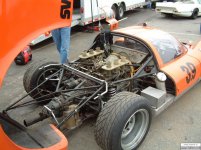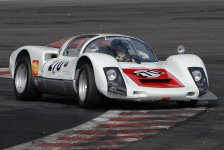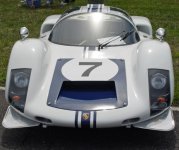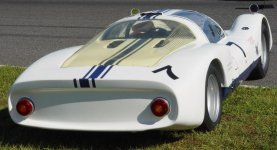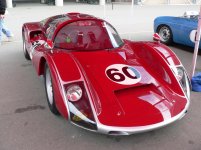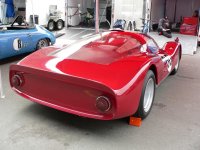Knut Omdal Tveito
Premium

Ferdinand Porsche with grandchildren Ferdinand Piech (right) and Ferdinand Alexander Porsche
With an ever changing staff in Porsche's experimental department, there was no shortage of fresh ideas, but at the expense of continuity and experience. Much of the experimentation done in Zuffenhausen concentrated on constructing racing cars, which not only won many races, but also served as rolling test beds for new developments. Under the guidance of Ferdinand Piech, Ferdinand Porsche's young grandson, a dedicated racing department was set up as part of the experimental department he headed. In his brief stint at Porsche, Piech had already worked on the development of the six cylinder engine of the 911 road car and the competition 904/6, before he officially took charge of the experimental department early in 1966. In the preceding months he already made his mark by developing the first of a line of highly successful racing cars all designed along the same lines.

The Porsche 904/6 (Image credits: Wouter Melissen)
In 1965, the works were still developing new six and eight cylinder version of the 904 GT racer. From the start the 904's design was compromised for ease of construction as a run of at least 100 cars were required for homologation purposes. The simple steel frame chassis construction was very rigid, albeit a bit heavy. In its first two seasons of racing this flaw was disguised by the car's excellent road holding characteristics and powerful engines. By the summer of 1965, Ferrari's radical and very light V6 engined Dino racer had exposed the 904's weak point and had rendered it obsolete on the spot in the European Hillclimb Championship. Piech's team sacrificed the traditional August break to develop an instant answer to the bright red mountain stormer. The 904's ladder frame was discarded in favour of a lighter spaceframe construction that had previously been used for many of the successful road racers. To lower the car, 13 inch wheels were planned to be fitted, but Porsche had no wheels of this diameter or suitable uprights available. In a unique deal the required bits were purchased from Lotus who used a similar setup for their Formula 1 racers and were than happy to ditch some of the spare parts after the German Grand Prix. Fitted with a lightweight spider body and a flat eight Grand Prix engine, the new racer made its debut at the end of the month in the Swiss Ollon-Villars hillclimb. Simply known as the Ollon-Villars Spyder, it showed its lack of development and testing, and Ferrari again took the better of the Germans.

The Ollon-Villars Spyder, chassis 906-010
Although the European Hillclimb Championship was a popular past time for the continent's racing car manufacturers it was not the top priority. The Ollon-Villars Spyder was not a winner out of the box, but did show great potential and its design would form the basis for the 904 replacement. All work on the larger engined versions was dropped in favour of the new spaceframe car. The sport's governing body, the FIA, had brought the homologation requirements down from 100 to 50 for Group 4 GT racers. The spaceframe chassis was still too complex for Porsche to construct in such a short time, but this was overcome by outsourcing the work to Karosseriewerk Weinsberg. Much of the development work concentrated on getting the light chassis up to the rigidity levels of the 904's. Once that was achieved a lot of time was saved by fitting the front and rear suspension that had contributed much to the old car's success. Many of the parts had already been ordered for the cancelled second 904 production run. The remaining time was spent on tuning and lightening the six cylinder engine found in the 904/6. In production form the new flat six already used lightweight materials like aluminium, but for the competition version Piech's team replaced the aluminium parts with magnesium and the steel bits with titanium. Magnesium was already used in the flat-eight Formula 1 project, but the use of titanium was previously restricted to space-ships only. The end result of the extensive diet was an engine that was lighter than the 904's four, yet still durable enough to survive endurance racing. Officially the engines produced 210 bhp, but a figure of 220 bhp was closer to the truth. This was almost twice the amount available in the similarly engined 911 road car. The very efficient shape was the result of 'Butsy' Porsche's intuition, but for the new racer the team relied on the windtunnel. The resulting fiberglass body was slightly lower and considerably wider that its predecessor's. Despite the increased frontal area, the drag was only slightly increased and the long nose provided for more downforce at high speeds.

Porsche 906 chassis

Porsche 906 Titanium conrods

906E (injection, not carby) Twin Plug Engine
The six cylinder engined 904/6 model received chassis numbers starting with '906' to distinguish them from the previous version. The 906 name was never publicly used so it was adopted by the factory as the cars official name. Not only did it follow the traditional naming policy, the last digit was also a true indication of the engine fitted. The PR department continued another tradition by referring to it as the 'Carrera 6', much like the 904 had been known as the 'Carrera 4'. Within a month after the first example of the 906 was completed, it made its competition debut in the January 1966 Daytona 24 Hours. Compared to the local racers, the tiny size of the navy blue Porsche became apparent. With a sixth place finish and a class victory, Porsche's latest racer immediately showcased its potential. Within a few weeks of the announcement of the new car, all 50 were spoken for. Before the car could be fully homologated the completed examples were forced to race in the prototype class where it again faced the similarly petit Ferraris. The Italians never planned to homologate the car and only one or two were usually present at any race and they quickly faced an armada of Porsche's latest. The two six cylinder racers were equally quick, but the quantity and durability of the 906 usually gave it an edge over the Dino. By the end of April the required 50 cars were completed and from May 1st it was homologated as a Group 4 GT. This was celebrated a week later in the Targa Florio where the 906 scored an overall victory. Porsche could comfortably leave the privateers to defend their honours on the track where it easily outran the competition. Not only did the new racer perform great on the track, it was also well received by the motoring press who quickly nick-named it 'Batmobile' because of its gullwing doors.

03.06.1966 Joseph Siffert in training session 1000-km of ADAC Nürburgring
Back in Zuffenhausen no time was wasted and immediately after the fiftieth car was completed, work was already started on improvements. Throughout the racing world the fueling system old, Carburetors, was replaced with Fuel Injection. In the preceding ten years much experimentation was done with injection, but it was not until the second half of the 1960s that a setup was developed that was really superior to the good old 'carbs'. For the 906 engine Porsche turned to fellow German's Bosch to replace the Webers with a state of the art system. Equipped with the Bosch injection the engine's performance did not increase, but it was much easier to fine-tune and offered better throttle response. Together with the new engine, a slightly revised bodywork was introduced, which brought drag levels back to the 904's figures without sacrificing any downforce. The evolution was dubbed 906E for Einspritzung, or injection, and was forced to run in the prototype class. One of the first outings for the injected 906 was the 1966 24 Hours of Le Mans race where they filled places four to six behind three Ford GTs. It also secured a top spot in the Index of Performance. A second evolution was the installation of the advanced eight cylinder engines in the chassis with hopes of creating an overall winner at the twistiest of tracks like the Targa Florio and the Nürburgring. The bore was increased slightly to create a displacement of 2.2 litres, which was good for at least 250 bhp. Four chassis, unofficially known as 906/8, were fitted with this revised unit, but did not attain the successes hoped for. Fortunately there were usually enough regular 906s around to pick up the pieces. Together with the Ollon-Villars Spyder, these evolutions of the 906 formed the basis for years to come, when the similarly engineered 907, 908, 909, 910 and 917 prototype and sports racers took on the racing world by force.
Piech's hard work paid off and Porsche won their first 24 Hours of Le Mans in 1970 with the 917K, which was the final evolution of the spaceframe Porsche sport's racer. Today the 906 is a popular choice in historic racing events like the Tour Auto retrospective and the Classic Endurance Racing series. Featured are two examples in action at various venues in 2005 including the Spa and Monza rounds of the CER and Tour Auto.
Article by Wouter Melissen (www.ultimatecarpage.com)
Attached below is some more resent photos of this beautiful car. Some of you might recognize the car in 2nd picture as Dr. Armin Zumtobel's car, made famous by the racing simulator GT Legends!

